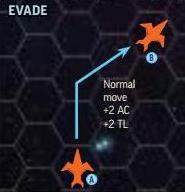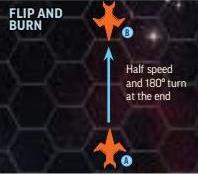If you fail your check by 10 or more, you overtax the ship’s systems without adding any useful capacity, and all engineer actions performed this turn take a –2 penalty.
Round Overview
Engineering Phase
The engineers on all ships (if present) each take an action to repair the starships’ systems or give them a boost. These actions occur simultaneously, so they can be resolved in any order.
Helm Phase
Each starship’s pilot attempts a Piloting check. The pilot with the lowest result must move his starship first, followed by the next lowest, until all starships have moved. This check is repeated each round during the helm phase, so the order of movement can change from round to round.
As they move their starships, pilots can attempt additional skill checks to perform dangerous maneuvers or push their vessels beyond their specifications. Also during this phase, any character taking on the role of science officer can use the starship’s systems to scan vessels or target foes. Science officers must act immediately before or after their starship’s pilot, but they can jointly decide the order they act.
Gunnery Phase
During the gunnery phase, gunners fire their starships’ weapons. Starships fire in the same order in which their pilots acted during that round’s helm phase, but the effects of damage are not taken into account until the end of the phase, meaning that all starships can fire, even if they take enough damage to be disabled or destroyed during this phase.
The Gray Lady
Medium Explorer
Speed 8; Maneuverability good (turn 1); Drift 1
AC 13; TL 11
HP 55; DT n/a; CT 11
Shields Basic 30
Attack (forward) gyrolaser (1d8)
Attack (turret) high explosive missile launcher (4d8)
Power Core(s) Pulse Gray (100 PCU); Drift Engine Signal Basic; Systems budget medium-range sensors, crew quarters (common), mk 2 armor, mk 1 duonode computer (tier 1)
Expansion Bays tech workshop, cargo hold (3)
Modifiers +1 any two checks per round, +1 Piloting
Build Points cost 55, max 55 Power Core Units non-essential 108, essential 95, max 100
Captain Actions
Chief Mate Actions
If you fail your check by 10 or more, you overheat and temporarily degrade the effectiveness of the starship’s maneuvering thrusters, causing the ship’s maneuverability to worsen by one step for the rest of this round.
If you fail your check by 10 or more, you overtax the ship’s systems without adding any useful capacity, and all engineer actions performed this turn take a –2 penalty.
If you fail the check by 10 or more, you knock the sensors out of alignment altogether, and no check to scan can be attempted this round as the system recalibrate.
If you fail the check by 10 or more, that gunner instead takes a –2 penalty to attack rolls they make this round.
This action can be taken more than once per round, but only once per gunner acting in that round.
Engineer Actions
| Condition | Actions to Patch | DC |
|---|---|---|
| Glitching | 1 | 10 + 1-1/2 times your starship’s tier (11) |
| Malfunctioning | 2 | 15 + 1-1/2 times your starship’s tier (16) |
| Wrecked | 3 | 20 + 1-1/2 times your starship’s tier (21) |
Magic Officer Actions
Choose one weapon on your starship to augment and attempt a Mysticism check (DC = 10 + 1-1/2 × your starship’s tier = 11). If you succeed, the gunner treats the range of that weapon as 5 hexes longer than normal. This does not work for weapons with the point special property.
- Basic Information: Living crew complement and ship classification, size, speed, and maneuverability.
- Defenses: AC, TL, total and current Hull Points, total and current Shield Points in each quadrant, and core PCU value.
- Weapon: Information about one weapon, including its firing arc and the damage it deals, starting with the weapon that uses the most PCU. Repeat this entry until all the starship’s weapons are revealed.
- Load: Information about how the starship’s expansion bays are allocated and any cargo the starship might be carrying.
- Other: Any remaining ship statistics
Pilot Actions
Stunts
 DC: 10 + 1-1/2 x Tier (11)
DC: 10 + 1-1/2 x Tier (11)Success: The ship moves up to half its speed in reverse without changing facing. It can't take any turns during this movement.
Failure: The ship moves backward only 1 hex.
Critical Failure (5 or more): The ship does not move at all and takes a -4 penalty to its AC and TL until the start of the next round.
 DC: 10 + 1-1/2 x Tier (11)
DC: 10 + 1-1/2 x Tier (11)Success: The ship moves up to half its speed and flips along its central axis. For the next gunnery phase, the starship’s port shields and weapons function as if they were in the starboard firing arc and vice versa. The starship reverts to normal at the beginning of the next round.
Failure: The ship moves half its speed but doesn't roll.
Critical Failure (5 or more): The ship moves only half its speed, doesn't roll, and takes a -4 penalty to its AC and TL until the start of the next round.
 DC: 10 + 1-1/2 x Tier (11)
DC: 10 + 1-1/2 x Tier (11)Success: The ship moves up to its speed and can turn as normal, but it gains a +2 circumstance bonus to its AC and TL until the start of the next round.
Failure: The ship moves as normal.
Critical Failure (5 or more): The ship moves as normal, and takes a -2 penalty to its AC and TL until the start of the next round.
 DC: 15 + 1-1/2 x Tier (16)
DC: 15 + 1-1/2 x Tier (16)Success: The ship moves forward up to half its speed (without turning) and rotates 180 degrees to face the aft edge at the end of the movement.
Failure: The ship moves forward half its speed but doesn't rotate.
 DC: 15 + 1-1/2 x Tier (16)
DC: 15 + 1-1/2 x Tier (16)Success: The ship moves as normal, but it can move through 1 hex occupied by an enemy starship without provoking a free attack. During the following gunnery phase, you can select one arc of your starship’s weapons to fire at the enemy vessel as if the vessel were in close range (treat the range as 1 hex), against any quadrant of the enemy starship.
Failure: The ship still moves as described above, but you follow the normal rules for attacking (based on your starship’s final position and distance), and the movement provokes a free attack from that starship as normal.
 DC: 10 + 1-1/2 x Tier (11)
DC: 10 + 1-1/2 x Tier (11)Success: The starship moves up to its speed in the direction of either the forward-port or forward-starboard edge without changing its facing.
Failure: The ship moves forward up to half its speed and can't make any turns.
Science Officer Actions
- Basic Information: Living crew complement and ship classification, size, speed, and maneuverability.
- Defenses: AC, TL, total and current Hull Points, total and current Shield Points in each quadrant, and core PCU value.
- Weapon: Information about one weapon, including its firing arc and the damage it deals, starting with the weapon that uses the most PCU. Repeat this entry until all the starship’s weapons are revealed.
- Load: Information about how the starship’s expansion bays are allocated and any cargo the starship might be carrying.
- Other: Any remaining ship statistics